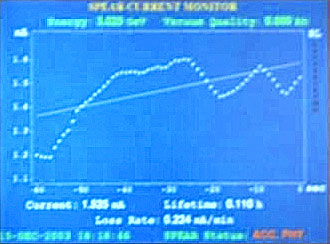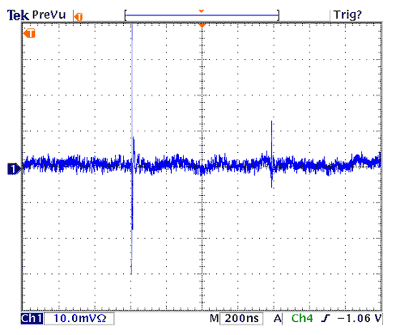SPEAR3 commissioning continues
to proceed remarkably smoothly, thanks to the efforts of the SSRL staff
and visitors from laboratories world-wide. 100 mA was first stored on
January 22. Since then the lifetime has been steadily increasing with
vacuum scrubbing, reaching 13 hours and climbing at 100 mA prior to
the week-long shutdown starting February 23.
Measurements of the electron
orbit show that it is very stable. The absolute orbit can be placed
in the storage ring magnet centers to within a couple tens of microns.
The fill-to-fill reproducibility of the orbit at the beam positions
monitors (BPMs) is about 1 micron. Without feedback, the orbit drifts
only a few tens of microns over the course of many hours. With orbit
feedba
ck, this is reduced to about 1 micron, as measured by the BPMs.
The rms orbit motion in frequencies between 1 and 100 Hz is about 2
microns, which compares well to other 3rd generation light sources.
Later this year, we will be implementing a fast orbit feedback to further
damp these frequencies. We see some small beam oscillations at the vertical
betatron frequency (300 kHz). These oscillations appear to be associated
with ions, and ar
e disappearing as the vacuum improves.
The linear optics functions
have been corrected to within a couple percent of design. Measurements
of the nonlinear optics distortions are also quite close to predictions,
which has resulted in good injection efficiency and lifetime (for this
stage of vacuum conditioning).
The remaining days
of storage
ring commissioning will be dedicated to investigating how much we can
push the optics to allow smaller gaps in future IDs, commissioning the
LIONs (a beam containment system), and preparing to deliver beam to
beamlines.
The speed and relative ease
of commissioning is a testimony to the excellent design, engineering,
and construction work done by the SSRL and
SLAC staff.
January 22, 2004
SPEAR3 Achieves 100 mA Stored
Current Milestone
Stored current in SPEAR3 reached
100 mA at about 10 pm Th
ursday Jan 22. The newly repaired Stored Current
Interlock stopped injection at 105 mA as specified. The lifetime at 100
mA was ~4.5 hr - not bad for now. We expect it to improve by a factor
of 10 or more when the ring is fully scrubbed and tuned up. Thanks to
the EE, EDM, Accel Phys and Operations staff who perservered in solving
the Current Interlock problems and enabling us to reach the 100 mA goal.
January 20, 2004
SPEAR3 Achieves 100 mA Stored
Current Milestone
Over the MLK holiday
weekend the commissioning team was able to verify the integrity of the
Orbit Interlock for protecting narrow-gap insertion device chambers from
mis-steering of upstre
am dipole radiation. Consequently, we proceeded
with the program to fill to 100 mA with IDs open, but were thwarted at
~52 mA by a mis-function of the Stored Current Interlock. No problems
were encountered with vacuum chamber pressure, heating, or beam instability.
The Current Interlock problem is expected to be resolved during the Tuesday
maintenance period, and the Orbit Interlock also will be modified to permit
ID operation at 100 mA. We hope
to be operating at 100 mA soon.
A dedication celebration is planned for Thursday, January 29th to recognize
the people who made the project successful as well as the state-of-the-art
science that SPEAR enables. More about this celebration will be posted
here as available. Please join in celebrating this milestone on January
29th!
Januar
y 1, 2004
Excellent Commissioning Progress
over the Holiday Break
The commissioning of
SPEAR 3 has progressed extremely well during the December holiday break.
The following message was sent by James Safranek, head of the commissioning
team, on New Year's Day, 2004:
"SPEAR3 commissioning has
been going remarkably well. The first beam
was stored on December 15th. Since then, we have been working to commission
the diagnostics, correct the orbit, and correct and control the linear
optics. To date we have limited the fills to 20 mA to avoid damaging the
vacuum chamber. We expect to push to higher currents sometime within the
next week.
"The speed and lack of problems with commissioning to date is a testimony
to the high quality of the accelerator. High praise goes to those who
designed and built SPEAR3!"
December 15, 2003
First Accumulated Beam in
SPEAR3!
The first accumulated beam
in SPEAR 3 occurred at 17:13:45 on Monday Dec. 15, 2003. It was stopped
at ~1 mA to allow conditioning of the vacuum system. The staff is now
pursuing measurements of beam parameters. Congratulations to all those
who have contributed to the SPEAR 3 project!
As has been the case throughout the SPEAR3 project, extraordinary teamwork
has been a key component. The SPEAR3 upgrade was made possible by the
joint support and funding by the U.S. Department of Energy and the National
Institutes of Health. Construction and installation work was performed
jointly by contractors and staff from SSRL along with numerous other divisions
at SLAC. The major milestone of first electrons circulating around SPEAR
was made possible by the accelerator staff here with assistance from the
A
dvanced Light Source (ALS). We particularly want to acknowledge David
Robin and Christoph Steier from the ALS for their late-night help in obtaining
the first turns. Congratulations and thank you to everyone who has made
and continues to make the SPEAR3 project both possible and successful!
December 12, 2003 
First Electrons Circulate
in SPEAR3!
Major milestones were observed
this week as SPEAR operators reported the first beam signals at SPEAR3
on December 10th - right on schedule! The following day around 2 am,
the first injection into SPEAR3 occurred when a single 3 GeV bunch was
inj
ected into SPEAR3 and made a complete turn around the ring. By the
afternoon of December 11th, 10-15 turns were observed, which is as much
as was expected without the RF system. On December 12th, operators plan
to turn on the RF system which will enable the possibility of actually
storing beam. These activities demonstrate that most of the major systems
are working as planned and provide encouragement that starting and commissioning
thi
s third generation light source at SSRL will continue to proceed
smoothly.